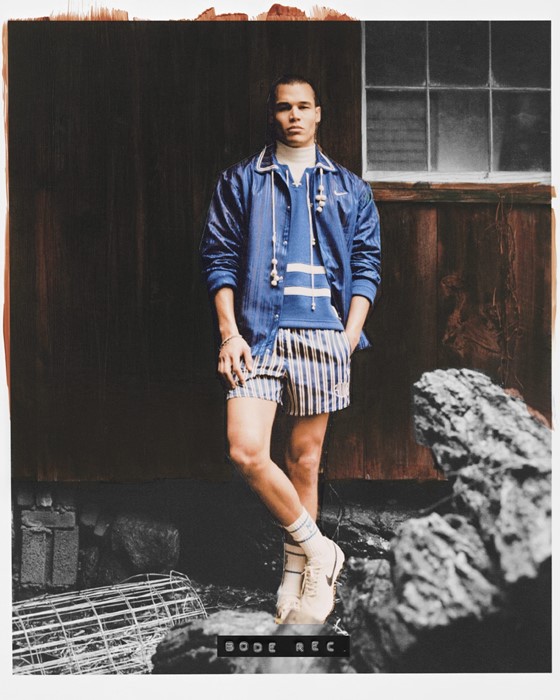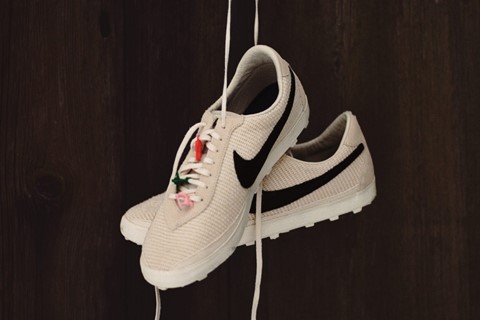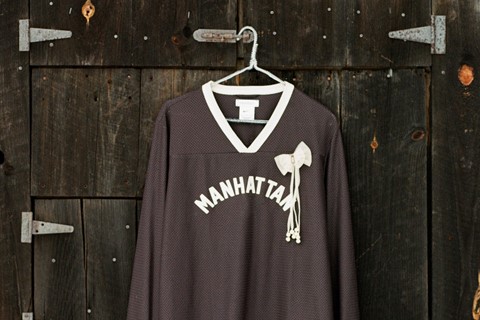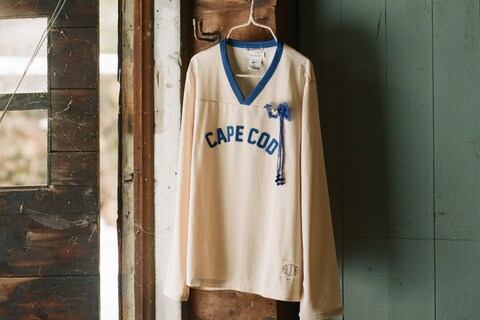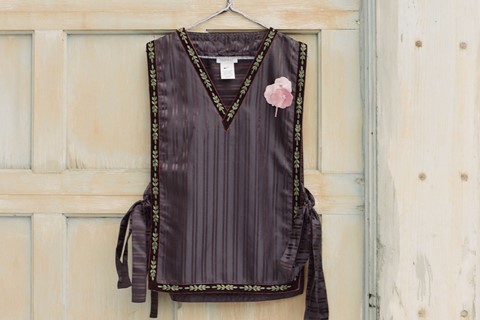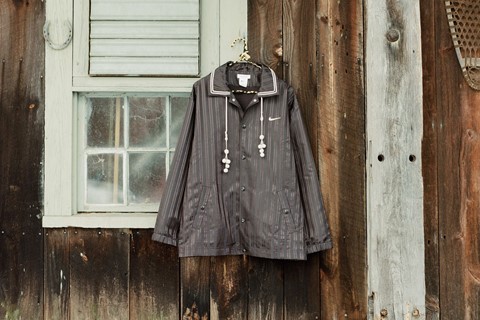As Bode’s highly anticipated Nike collaboration is released in stores, Emily Bode Aujla talks about the athletic references behind the collection
In 1971, Emily Bode Aujla’s father graduated from high school in Massachusetts as co-captain of the football team. That same year, Nike co-founder Bill Bowerman took up the challenge of crafting a football shoe that could keep traction on new Astro-Turf fields. With this timely synchronicity, it’s only fitting that the resulting design, the Astro Grabber, (which, until now, has never been re-released) is at the heart of Bode’s collaboration with Nike.
To find common ground between Bode’s luxury tailoring and Nike’s athletic apparel, the designer peeled back the layers of the sportswear label’s mighty history to its founding values: sportsmanship and citizenship. Classic athletic silhouettes are laced with Bode Aujla’s ever-intelligent and often hand-crafted detailing, which bring to light tales of America’s robust sporting culture – and Nike’s hand in forging it.
To celebrate the historic collaboration, AnOther caught up with Emily Bode Aujla in Paris to discuss how the five-year-long project came to fruition.
Madeleine Rothery: Why collaborate with Nike?
Emily Bode Aujla: When I launched Bode in 2016, we had a lot of outreach from brands wanting to collaborate. But I’ve always said that I only wanted to work with Nike because, for me, it’s the best apparel brand in sportswear in America and has a similar ethos and origin story to Bode. It was founded by people who were really passionate about what they were doing.
I also have a funny story – the founder of my high school was an avid runner and so was his son. His son was close friends with Jeff Johnson, employee number one of Nike. So when I first started talking with Nike, it was super important for me to speak with him and other early employees. We went to Jeff’s house, and he showed me all of his photography archives – he was the one who came up with the name Nike and was the first to think of advertising. He would just position the shoe on his couch, take a picture of it, then run those ads.
MR: Storytelling is at the heart of Bode. What’s the tale told through this collection?
EBA: Jeff was a coach and I really like his philosophy about why athletics and recreation make you a better person. So much of the research I did around this collection had to do with the importance of sport in American society. I was looking at institutional sports within middle schools, high schools, and universities. A lot of the laws and programs that came into place started about 100 years ago. I think similarly for Jeff, sports must be integrated into these institutions because of the promise of making better citizens – becoming masters of themselves, having better team unity and better moral understanding. The way he coaches, he understands that the athlete is first and foremost, even above winning.

MR: Why did Nike’s Astro Grabber shoe interest you?
EBA: [At the Nike HQ] in Beaverton, I visited this tiny little workshop in the basement off the beaten path of the main HQ area. It’s where Bill Bowerman was making shoes for his athletes, like the Waffle shoe, made with actual waffle irons. It all culminated with the fact that, in 1971, my dad graduated from high school in Massachusetts – he was co-captain of his football team and went to college to play football. That same year, Nike was tasked with making a football shoe for synthetic turf because the shoes that existed were not viable and a lot of people were slipping. So, it all came to fruition that the shoes that I was looking at were from that same period. Jeff Johnson took a couple of photos of UCLA athletes wearing the original black leather Astro Grabber on the field in 1973 before they even hit the public market. One of the guys had to colour in his shoe to meet the uniform standards. And that’s the one that ended up on the cover of Sports Illustrated.
We worked with the team at Nike to make a couple of handmade shoes as part of the process. It was really fun to think of all of the different elements, like the shoelace thickness and how that translated into a handmade shoe, because they were all originally made by hand in Bill’s basement. There are all these beautiful stories that were so organic to Nike’s origins that I wanted to touch on for this collaboration.
MR: How did you weave the Bode aesthetic and ethos into the collection?
EBA: Talking with the archivists at Nike was such a huge part – we got all these anecdotal stories. For example, the thermals are based on this story that in the 60s and 70s, the runners would train in their thermals because the sweatpants were too heavy to wear. And then the neighbours in Oregon would call to complain that the boys were running in their underwear.
There’s also more hidden research that I was doing. One of the dresses that just launched as part of Bode Recreation, our own line, was based on a 1922 French dress that had this hand-beaded Laurel pattern. And we used that on the Nike track pants too. I wanted to include that because 1922 was when the first Jeu de Femmes was, the female Olympic games.
The jerseys refer to 1756 when there was a boat race in New York City Harbour between a Cape Cod sailing vessel and a Manhattan whaling ship. So that’s why they have ‘Manhattan’ and ‘Cape Cod’ written across the jerseys. And the handmade knots refer to nautical knots and the sailors. They are very specific to this competition.
The Nike x Bode collection is available online at Nike.
